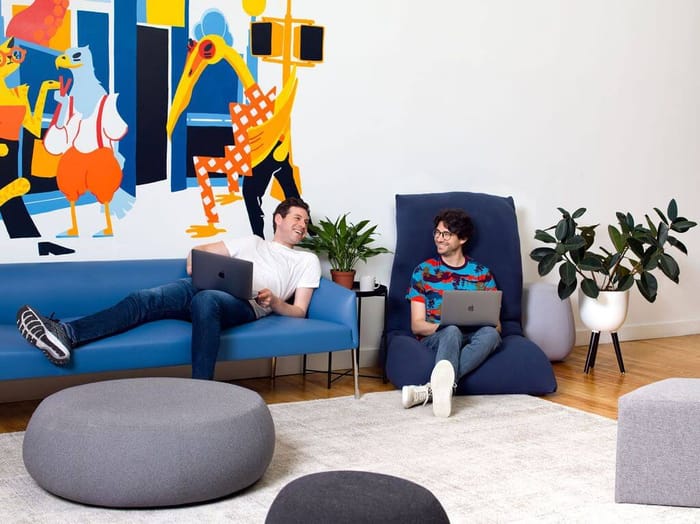In 2011, the clarion call of the tech space was for everyone to “learn to code.”
That year, the online programming school Codecademy raised its first funding round of $2.5 million.
That year, technology’s relationship with society was rapidly shifting; Twitter had become the nexus for social movements such as Occupy Wall Street and the Arab Spring.
That year, twenty-five-year-old Josh Haas had moved to New York City after leaving his role at Bridgewater Associates to pursue a life outside of hedge fund management.
Josh, a Harvard graduate in philosophy, already knew how to code. He had spent parts of his childhood teaching himself Visual Basic to make his own video games and built custom AI components in his favorite real-time strategy game, a 1995 indie gem called Solar Vengeance. He later dabbled professionally in PHP, C, and Java. And though his Harvard philosophy thesis was on the intersection of Kant and Buddhist theory of ethics, Josh had decided his philosophical pursuits would eventually have to make way for practical projects.
But joining a startup was not something he expected to do.
On a whim, Josh found a site called “techcofounder.com” (now known as CofounderLabs) and created a profile for himself. He was immediately bombarded with messages from entrepreneurs desperate for an engineer to join their ventures.
“I realized there was this huge mismatch between the number of engineers and the number of people who wanted to found companies,” Josh said. “A lot of people want to build a digital startup, but don’t always have the technical expertise to create their product.”
Josh was hesitant to respond to the numerous inbound offers he received. He weighed these founders’ different ideas – from a Spotify competitor to an SEO blog ranking startup – and was not convinced by most of what he saw.
Then, Jody Apap reached out. Jody stood out to Josh among the sea of solicitations.
“He was this guy in his 40s with a wife and kids,” Josh explained, “who spent years in this domain-specific space of keywording images.” Assigning keywords to images for online search engines to read and catalog was an extremely niche job. Jody had apparently keyworded more than 250,000 images himself and wanted to build a computer program to make his life and other keyword loggers’ lives easier.
“Here was someone who spends a ton of time doing this one thing–keywording stock photos–and he has an idea for ‘a better mousetrap,’” said Josh. “He was a high integrity person; the kind I would trust and respect as a co-founder.” So, Josh agreed to help Jody build a better mousetrap.
A Better Mousetrap: The Startup That Started It All
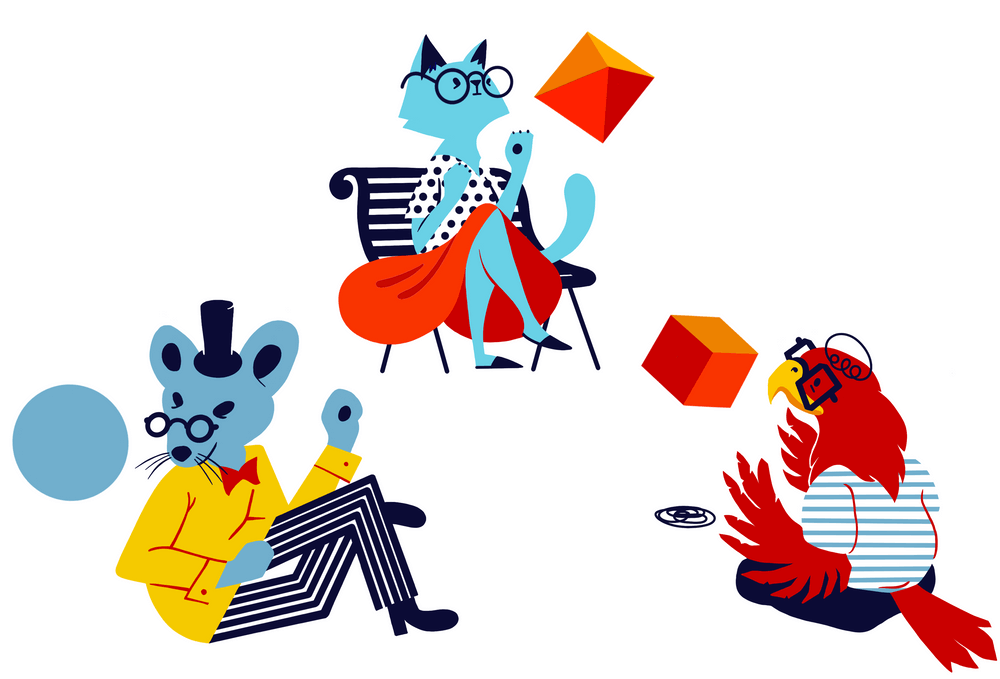
Build a better mousetrap, and the world will beat a path to your door.
- Ralph Waldo Emerson, sort of.
Together, Jody and Josh created KeywordSmart, a tool that helped professional photographers and image asset managers better organize their photo libraries. It was essentially a cross between a thesaurus and a checklist, that allowed people to look at an image they wanted to keyword and answer questions about the various commonly keyworded aspects in the picture (e.g. the number of people, age, gender, clothing, location, etc.). They sold the product as a software-as-a-service for $50 a month to users.
But KeywordSmart faced a number of business challenges. The market of keyword loggers that would benefit from the service was incredibly small. Most stock photographers who keyworded maybe 10 to 20 images at a time didn’t feel the need to pay for a subscription and preferred to just work manually. Very few people like Jody needed to keyword 100,000 or more images.
“The product had a ‘long tail,’” said Josh, “but for those who did use us, like some consulting firms who managed large media libraries, they LOVED it.” KeywordSmart was, unlike some more infamous startup ideas, a useful tool–it just had a small market. There was also no naturally existing community to find customers, and in a growth-focused venture capital culture, these factors proved to be problematic for potential fundraising.
After almost a year of bootstrapping together, earning some revenue but not enough to pay their salaries, Josh had a tough decision to make. He felt guilty for leaving his co-founder. While trying empathetically to figure out a path forward for Jody and the company when he left, Josh had an idea: what if there were a platform where someone like Jody could build their startup without an engineer?
“The internet makes it so powerful, so easy to start a business and deliver real value to people,” Josh explained. “When working with my non-technical founder, I kept thinking, ‘I wish he could have the means to do this himself.’”
After all, Josh’s co-founder was a domain expert; no average engineer alone would have conceived of KeywordSmart. And while it wasn’t going to be the next Uber or Facebook, KeywordSmart was a helpful tool that made people’s lives easier and could have been a modest small business for Jody without the need for an engineer’s salary. Jody also had the drive; he had done his best to learn everything he could about the technical product, including some basic HTML to help Josh. But it would have taken Jody too long to learn how to code and maintain the project himself. Josh left wondering if there could be a better way for entrepreneurs like Jody.
Finding a Path Forward as Entrepreneurs
After leaving KeywordSmart in 2012, Josh started coding a project that would become Bubble: a tool to help non-technical founders build their ideas without needing to learn how to code. Josh soon found himself in the same position as the people who had solicited him earlier: looking for a co-founding partner.
Emmanuel Straschnov was attending Harvard Business School at the time. Emmanuel was born in France and had a background in science and technology from his polytechnic education. Emmanuel had just come from a stint in the world of luxury brands and fashion as well as consulting in China, but he decided that he wanted to focus on the business of technology products. While at HBS, a mutual friend recommended Josh to him.
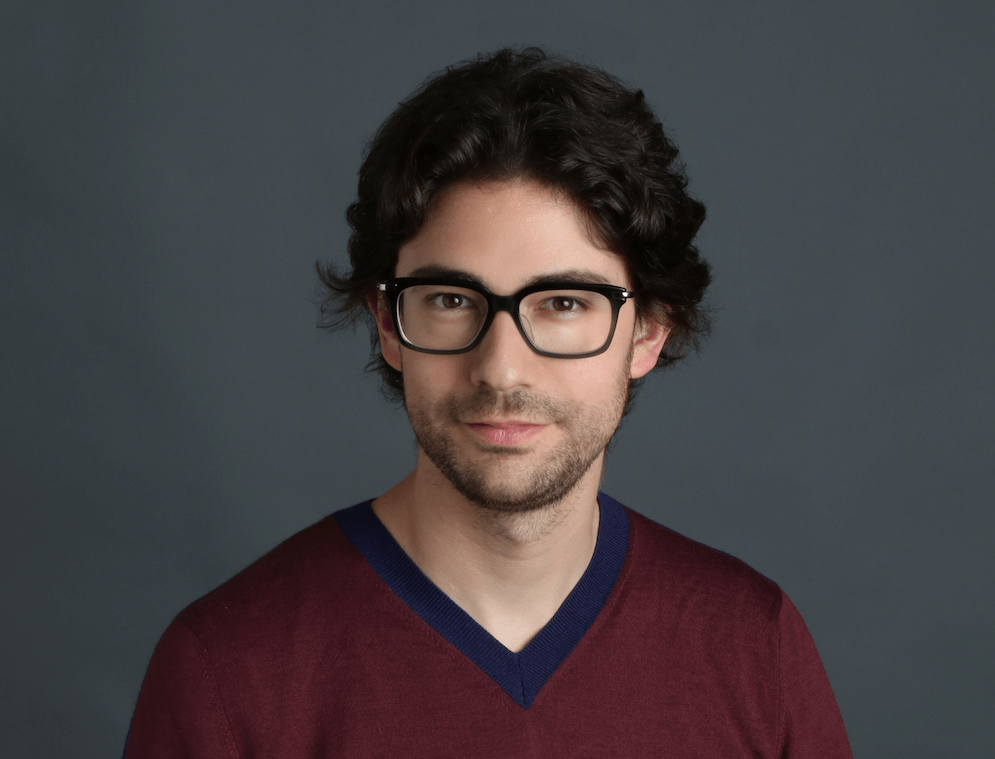
The story is that they met for coffee on a Thursday. Emmanuel already had another job lined up whose offer was expiring the next day. They talked for three hours about everything except the product, before Josh showed Emmanuel what he was working on so far and suggested they work together. Emmanuel agreed the next day.
“It was more than just a mere website builder,” Emmanuel realized. “Josh’s prototype already had the workflow and data tab system, which is still a core part of Bubble today.” Both founders recognized the potential for a platform that could allow people to create a fully functional web app, not just a flashy landing page for a website, without requiring users to write code. They chose the name “Bubble” as a sly nod to the concept of a “tech bubble,” maybe one they would someday help burst.
It was an ambitious project. When Josh and Emmanuel started working on Bubble, “no-code” tools were not really a category of their own. Wordpress and Drupal existed, revolutionizing the creation of blogs and other content management platforms. Squarespace, Wix, Weebly were already gaining traction as a way to build websites without learning HTML and CSS. But coding was still considered the gold standard of technology creation, reinforced by the mindset of Silicon Valley venture capitalism. Josh recalled that accelerators like Y Combinator would evaluate projects based on the “quality of their engineering teams.” (Since then, several Bubble-based startups have been accepted into Y Combinator and other top accelerators.) At the time of “everyone should code,” Bubble’s goal of helping you launch a startup without engineers might have seemed even more “disruptive” than the unicorns that VCs were chasing.
Emmanuel and Josh’s perspective was different: Bubble wasn’t a new or disruptive idea at all, but the next inclusive step in the longest journey of technology: the journey of making incredibly complex things simpler. From the command line to the first user-friendly operating systems, the world has moved toward making it easier for everyday humans to interact with their computers, not just as software users, but as software creators. Josh firmly believed in empowerment, not disruption–and expanding the number of people who could create technology required making it easier and more affordable to build software.
Bubble realizes the promise of early “visual programming” languages that have struggled to be anything more than educational teaching tools or mere stepping stones on the path toward “real programming.” A fundamental principle of Bubble is that “coding” and “programming” are not the same. The skill of programming is the ability to think logically through the structure of an app and its workflows. The skill of coding is knowing the rules to type that logic in a way that a computer will understand. But shouldn’t computers learn to speak our language, not the other way around? Emmanuel argued. Maybe the “learn to code” mantra was promoting the wrong skill. If we take coding to be basically akin to old-fashioned typesetting, then Bubble would be the word processor for writing apps.
Meanwhile, Josh had been exploring the realm of “domain-specific” programming languages: the idea that a computer language should be purposefully created and tailored to the tasks its users are using it for. Many languages are general purpose, like Python and Javascript, which give them greater versatility but also sometimes create frustrating amounts of work for simple tasks and more room for bugs and errors. Josh saw Bubble as a domain-specific language for building web applications, a visual job that made sense to be visually represented. The challenge now was to make this vision a reality, for both the founders and for future users.
Bubble’s Bootstrapping Years
Despite the fact that Josh had thought he wanted a co-founder who could run the “business side of things,” the truth was there was little business to be done without a good product. In 2012, Bubble’s product still needed more development, and as co-founder, Emmanuel wanted to be a bigger part of the process. Josh remembers picking up a book on JavaScript and CoffeeScript at Barnes and Noble for Emmanuel who essentially trained himself into a front-end developer for Bubble.
Josh and Emmanuel spent several years going through a phase familiar to many early-stage startup founders: working out of coffee shops and WeWorks while pitching potential customers anywhere they could at entrepreneurial meetups and networking events in New York City.
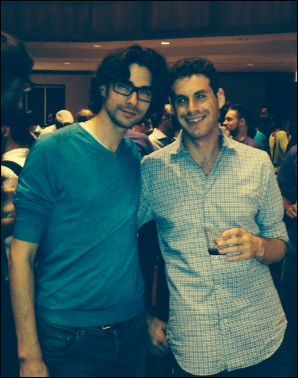
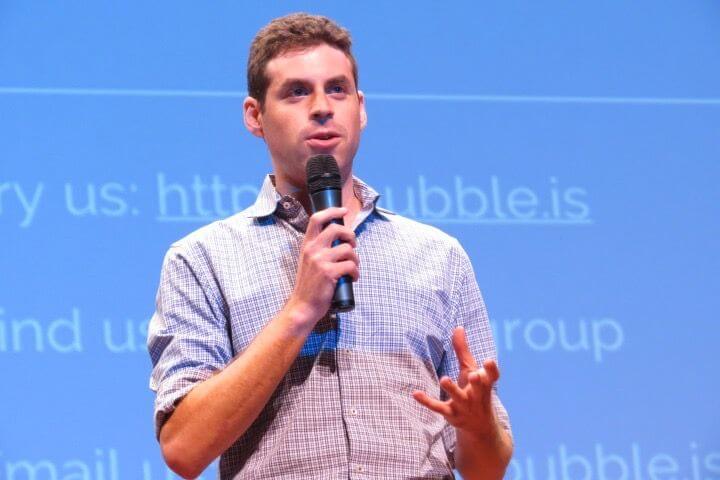
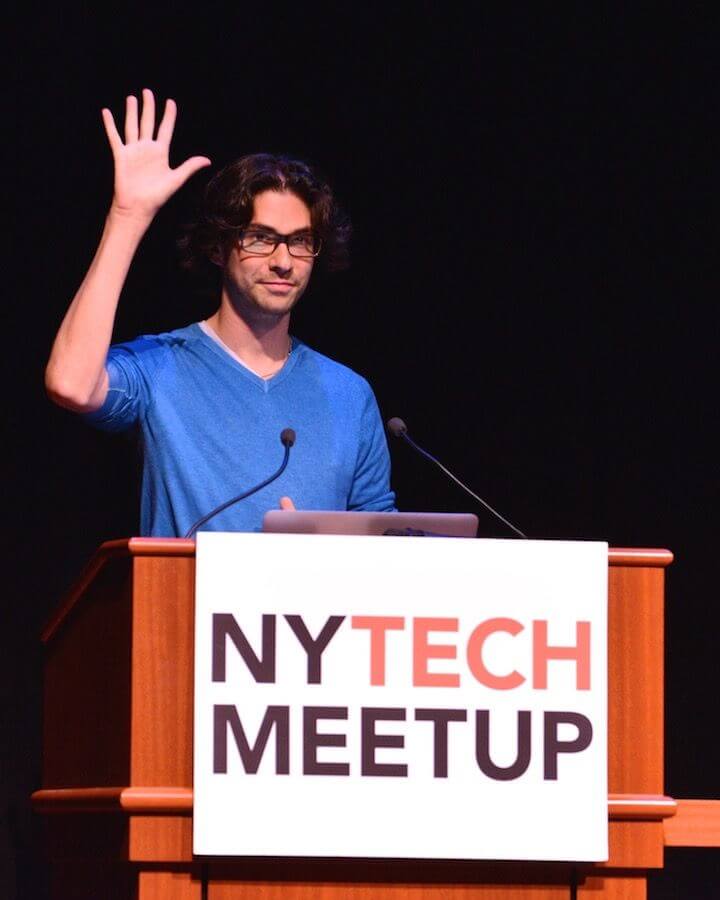
Emmanuel and Josh in the early Bubble years hustled for customers in New York City's growing tech scene.
“The early demos were tough,” Emmanuel admitted. “Users expect to be able to do anything that they can see in other web apps, so we didn’t want to launch too soon; it felt necessary to take years to develop the product’s functionality.”
Even though the early product experience wasn’t the prettiest, Bubble gained customers through word of mouth. It became clear that certain people, especially early-stage founders and aspirational tech entrepreneurs young and old, were desperate for an alternative to the engineering and investment-heavy model of modern startup culture. Bubble offered them an affordable alternative that could get them started faster than hiring a team of developers or learning to code themselves.
Bubble had its first paying customer in December 2012; Ari Klickstein built a financial literacy company on Bubble’s platform. He began paying $50 a month to white label his app on a custom domain.
“We didn't even have any payment provider integration back then since we were still building our own user portal,” Emmanuel said, “so we took a check. I still have a photo somewhere.”
It was a big moment. In a few years, Bubble would have more major customers, including Dividend Finance in 2014, whose aggressive scaling pushed the platform to its limits a number of times. In 2015, the founders posted Bubble on Product Hunt and it became one of the highest upvoted products at the time, getting Bubble more than 3,000 users overnight. One MBA student used Bubble to make a clone of Twitter.
The growing buzz meant it was time to seriously consider the roadmap of the product and the team. Initial investor conversations left a bad taste in the founders’ mouths. Josh admitted that the founders and investors were “speaking past each other” in meetings and they hadn’t yet fine-tuned Bubble’s pitch. But the advice they were getting from VCs at the time–for instance, to “pick a vertical and make the product more specific to some use-case”–didn’t sit right with them.
“The big question at the time was: Do we ‘dumb it down’ for people?” Josh recalled. Josh and Emmanuel decided not to compromise on Bubble’s functionality and freedom. “The most important goal for us was to build a tool that could do anything. We wanted a platform powerful enough to build the next Facebook or Airbnb.”
Emmanuel and Josh always knew they wanted to grow the team to realize the vision of Bubble to be a “no-code” platform for startups and entrepreneurs to build their dreams. “But we wanted to focus on being sustainable, delivering value to customers first,” Emmanuel said. They decided not to take any venture capital money at the time and continue bootstrapping, growing their team as their revenue and users grew.
In 2017, after years of iterating on Bubble and expanding the platform to gain customers, Josh and Emmanuel finally began bringing on more engineers to help keep up with feature building. They then brought on customer success to address community feedback and operations to manage their growth. For two years as a team, Bubble was self-financed with organic revenue; it wasn’t always easy, but by the time the fundraising conversations came around again, Bubble had over 250,000 users, $1 million in annual recurring revenue, and a platform that could scale.
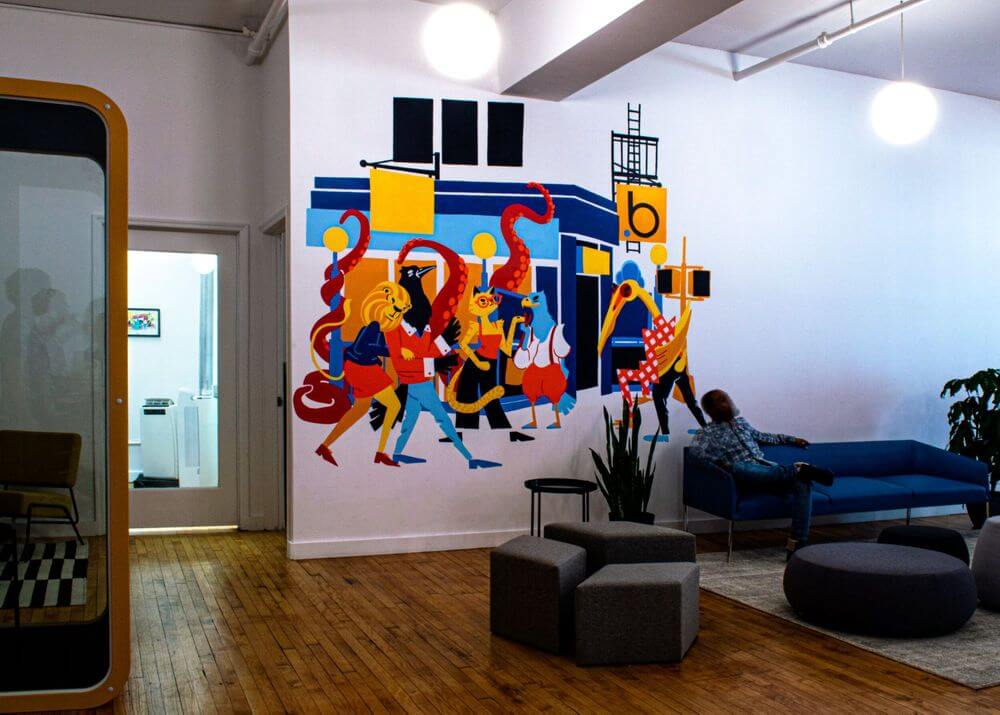
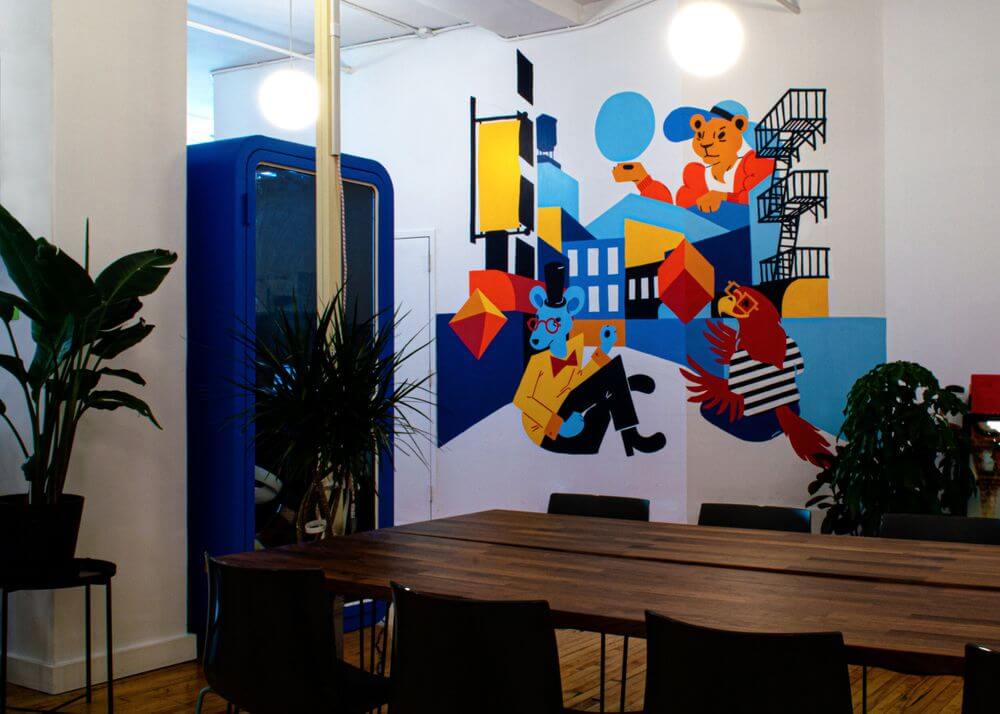
Bubble's Flatiron office with Alfredo Gadberry's illustrations.
People were also finally understanding what “no-code” really meant; folks in the entrepreneurial community were coming around to the idea that it might not be necessary to be an expert engineer just to create an online business. And while Emmanuel and Josh were technically programmers, even they wished it were faster and easier to prototype and build basic web apps, without spending months typing into a terminal. No-code benefits both coders and non-coders. To Bubble’s founders, it offers a more sustainable path of entrepreneurship for those that will follow in their footsteps, a path that doesn’t rely on technical co-founders or expensive engineering teams to simply get a business idea off the ground.
No-Code Now and In The Future
Bubble became a venture-backed company in June 2019. In its seed round, Bubble secured $6.25 million from angel investors at SignalFire and Neo, founders at Allbirds, Warby Parker, Harry’s, and Nas (yes, that one). Then, in 2021, Bubble announced a whopping $100M Series A round, led by Insight Partners, who happened to be one of the very first investors that ever reached out to Josh and Emmanuel in 2014.
Bubble has grown to help millions of users. The “no-code” movement has grown too, with businesses built around Bubble and a larger no-code ecosystem cropping up to support people creating their products without following the traditional startup path. Bubble’s goal remains the same: to become the go-to place for all startups and entrepreneurs beginning their journey to building a web application.
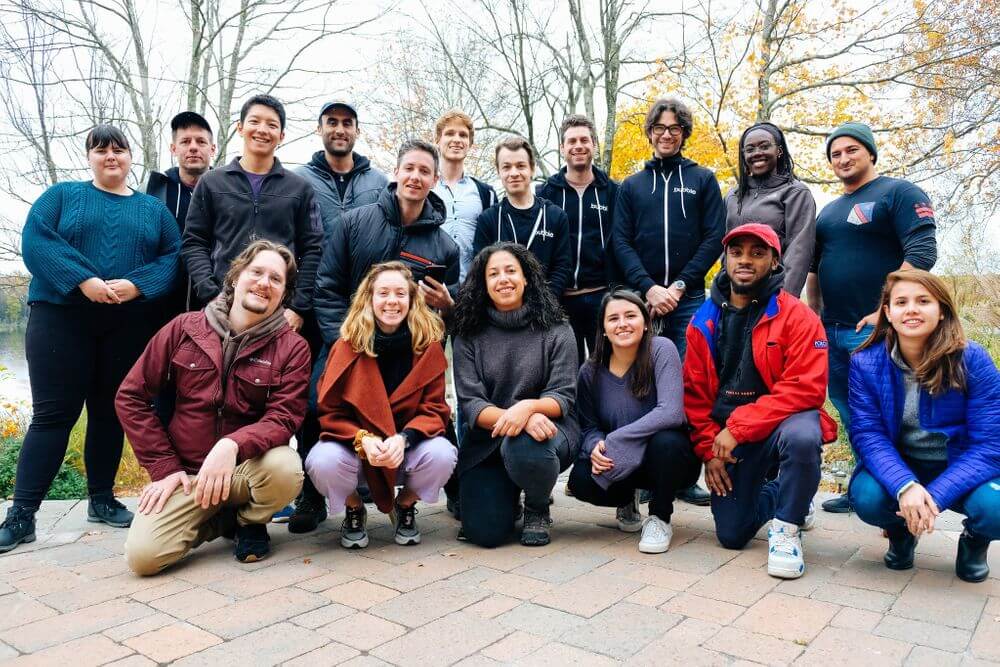
The Bubble team is growing everyday, but the scrappy ethos of the team and core functionality of Bubble’s platform remains constant, even as the visual web editor becomes slicker with more bells and whistles and the underlying servers grow more numerous and efficient.
At Bubble, we are working on an old problem, one that many have tried and failed to solve: the visualization of logic that erases the line between using technology and creating technology. Every piece of new tech should ideally make something that was once complicated simpler or easier, improving people’s lives along the way.
But what makes us different is that we aren’t just paying lip-service to the democratization of technology–we’re bringing it to your browser. Bubble was built to solve a problem not for its founders, but for the Jody’s and other everyday entrepreneurs in the world. Our mission is to support anyone who has ideas for new forms of value, for empowering innovations, or even just for better mousetraps.
Build for as long as you want on the Free plan. Only upgrade when you're ready to launch.
Join Bubble
